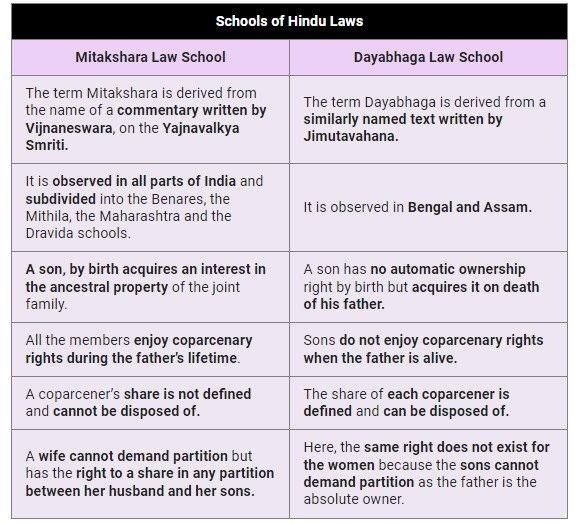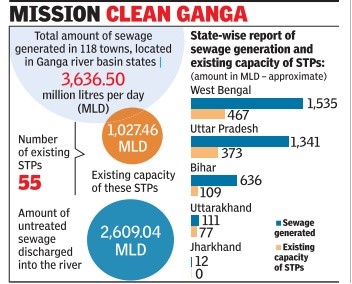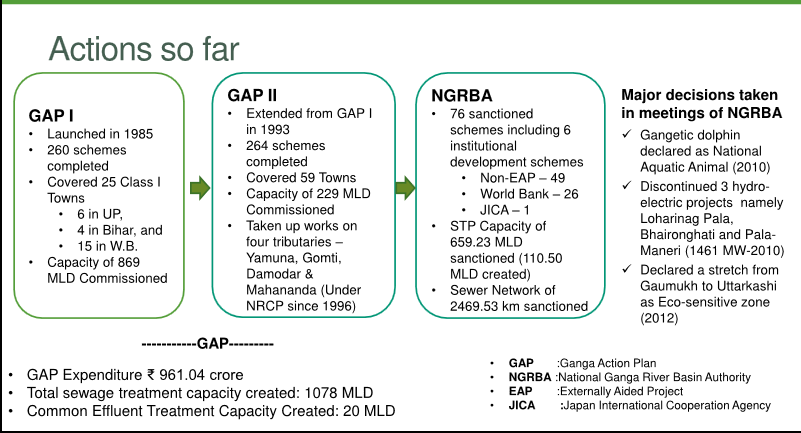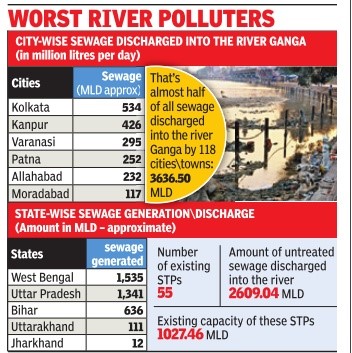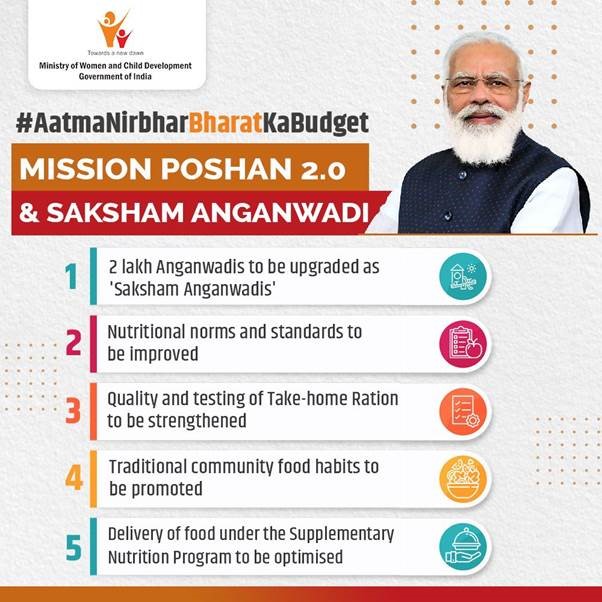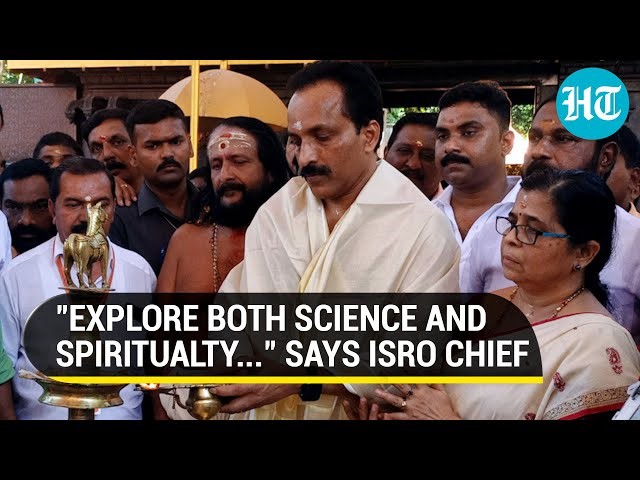Topics:
- Mitakshara Law of Succession
- NMCG A Review
- Mercy Petition in BNSS,2023
- 6th Rashtriya Poshan Maah
- Spirituality with Science
- Women Empowerment & role of trinity act in it
- Marine Heatwaves
MITAKSHARA LAW
Context:
- The Supreme Court has clarified that offspring born from marriages considered void or voidable under the Mitakshara law can inherit their parent’s share in a joint Hindu family property.
- However, it is essential to note that these inheritance rights are limited solely to the parent’s portion and do not extend to properties belonging to other family members.
Nature of Marriages and Legal Framework:
- A voidable marriage becomes invalid through a decree issued by either the husband or wife.
- On the other hand, a void marriage is inherently invalid from its inception.
- The Mitakshara Law of Succession applies to Hindu Undivided Families throughout India, except for the states of West Bengal and Assam.
Ruling Details:
- The Supreme Court, led by Chief Justice D.Y. Chandrachud, has clarified that children born from void or voidable marriages are not entitled to claim a share of other family members’ properties.
- Their inheritance rights are specifically linked to their parent’s portion in the ancestral property.
- To determine this share, a “notional partition” is conducted immediately before the parent’s demise.
Inheritance Calculation:
- The law assumes a partition of the ancestral property between the deceased parent and other family members before the parent’s death.
- The child’s inheritance is determined based on the portion the parent would have received through this notional partition.
Legal Basis:
Section 16 of the Hindu Marriage Act provides legitimacy to children born from void or voidable marriages, entitling them to their parent’s property. This intent is reflected in the Hindu Succession Act.
Impact of Amendment:
- The Hindu Succession (Amendment) Act of 2005 permits a deceased person’s share in a joint Hindu family property to be inherited through testamentary or intestate succession, whereas before the amendment, devolution only occurred through survivorship.
- This amendment grants equal succession rights to both women and men.
Background and Precedents:
- The case primarily revolved around Section 16(3) of the Hindu Marriage Act.
- In 2011, a Division Bench of the Supreme Court championed the inheritance rights of children born from marriages considered illegitimate, emphasizing their entitlement to the same rights as children born from valid marriages.
Conclusion:
The concept of legitimacy has evolved in line with changing social norms. The court has recognized that what was once deemed illegitimate may be considered legitimate in contemporary society.
Therefore, children born from void or voidable marriages should not be deprived of their inheritance rights based on evolving social consensus.
Basics of Mitakshara Law
Mitakshara Law | Description |
Origin | Mitakshara law is a legal commentary on the Yajnavalkya Smriti, written by Vijñāneśvara, a scholar in the Western Chalukya court in the late eleventh and early twelfth century. |
Scope | Mitakshara law is applicable to most parts of India, except Bengal and Assam, where Dayabhaga law prevails. |
Features | 1. Mitakshara law is based on the concept of joint family and coparcenary(refers to a person who has the capacity to assume a legal right in his ancestral property by birth), where the male members of a family have a right by birth in the ancestral property.
2. The property devolves by survivorship, meaning that the surviving coparceners inherit the share of the deceased coparcener.
3. The rule of succession is based on propinquity, or the closest blood relation, and prefers agnates (male relatives through male line) over cognates (relatives through female line).
4. Females are generally excluded from inheritance, except for some cases like widow or daughter. |
Dayabhaga Law
Dayabhaga is a Hindu law treatise that deals with inheritance and property rights. It was written by Jimutavahana, a scholar in the 12th century.
It is mainly followed in Bengal and Assam, and differs from Mitakshara law, which is followed in most other parts of India.
Main Features:
- The son does not have any right to the father’s ancestral property until after his death, or when the father loses his ownership due to other reasons. The property is divided among the heirs at the time of the father’s death, not before.
- The widow inherits the husband’s property as his representative, even if he had joint property with his brother. She can also adopt a son without the consent of her husband’s relatives.
- The rule of succession is based on spiritual benefit, not blood relation. The heirs are those who can offer oblations to the deceased and help him attain salvation. The preference is given to sapindas (relatives connected by a common ancestor) over sakulyas (relatives connected by common descent).
- Females are included in inheritance, and have equal rights as males. They can also inherit from their maternal relatives.
Dayabhaga law has been reformed by the Hindu Succession Act of 1956 and its amendment in 2005, which gave more rights to daughters and abolished the distinction between ancestral and self-acquired property.
NMCG - Review
Context:
- The National Mission for Clean Ganga (NMCG) is dedicated to purifying the Ganga River by addressing sewage issues in five major states through sewage treatment plants (STPs) and sewerage networks.
- Over a span of seven years, NMCG has successfully achieved a sewage treatment capacity of 20%, with a goal of reaching 60% by December 2026.
Current and Future Sewage Treatment Capacity
- Currently, NMCG is treating approximately 20% of the sewage generated in the Ganga river basin.
- The treatment capacity is anticipated to increase to 33% by 2024 and eventually reach 60% by December 2026.
- The estimated sewage generation in the five states (Uttarakhand, Uttar Pradesh, Bihar, Jharkhand, and West Bengal) is around 11,765 million litres per day (MLD).
Role of NMCG
- NMCG’s primary objective is to prevent untreated sewage from contaminating the Ganga River.
- It’s important to note that the projected 11,765 MLD includes sewage generated within the states but does not necessarily all flow into the river.
- NMCG’s plan includes the establishment of sewage treatment capacity totaling 7,000 MLD by 2026.
Projects and Progress
- Approximately 80% of NMCG’s efforts are focused on STPs and sewerage networks.
- As of July 2023, functional STPs are treating 2,665 MLD, with an addition of 1,455 MLD in the last fiscal year.
- Some project delays have been encountered due to challenges related to land acquisition and revisions in Detailed Project Reports.
State-wise Distribution
- The majority of STPs are located in Uttarakhand (36), followed by Uttar Pradesh (35) and West Bengal (11).
- Despite having a budget of ₹20,000 crores, NMCG has given in-principal approval for projects worth ₹37,396 crores, with ₹14,745 crores already allocated for infrastructure work by June 2023.
Positive Water Quality Indicators
- The water quality of the Ganga River now complies with the prescribed limits for primary bathing water quality.
- Encouragingly, there has been an increase in the dolphin population (from 2,000 to 4,000) and the presence of Indian carp in cleaner waters, indicating nature’s approval of river improvement efforts.
- NMCG is also working on establishing a water quality index similar to the air quality index to facilitate better communication of water quality standards.
Conclusion
The progress achieved by NMCG reflects a positive trend in the restoration of the Ganga River, evidenced by improved water quality and a thriving aquatic ecosystem.
The mission’s ongoing efforts are dedicated to addressing sewage treatment challenges and promoting cleaner water resources.
Basics
Introduction
- National Mission for Clean Ganga (NMCG) is the implementation wing of National Ganga River Basin Authority (NGRBA), which was constituted under the provisions of the Environment (Protection) Act, 1986.
- NMCG was registered as a society on 12th August 2011 under the Societies Registration Act 1860.
- The aim of NMCG is to ensure effective abatement of pollution and rejuvenation of the river Ganga by adopting a river basin approach to promote inter-sectoral coordination for comprehensive planning and management.
Vision and Mission
- The vision of NMCG is to restore and maintain the wholesomeness of the river Ganga in terms of its ecological, spiritual, cultural, and economic value.
- The mission of NMCG is to achieve this vision through the implementation of the flagship programme, Namami Gange, which integrates the efforts to clean and protect the river Ganga in a comprehensive manner.
Objectives and Activities
- Develop a comprehensive river basin management plan for the Ganga River Basin.
- Implement projects and activities for pollution abatement, conservation, restoration, and rejuvenation of the river Ganga and its tributaries.
- Monitor and evaluate the progress and impact of the projects and activities.
- Promote research and innovation in the field of river ecology, pollution control, waste management, and environmental engineering.
Enhance public awareness and participation in the conservation and management of the river Ganga.
Some of the activities undertaken by NMCG are:
- Sewage treatment infrastructure: To create sewage treatment capacity, intercept and divert sewage from drains, rehabilitate existing sewage treatment plants, and adopt innovative technologies for sewage treatment.
- Industrial effluent management: To enforce zero liquid discharge norms, install online effluent monitoring systems, close down polluting industries, and adopt cleaner production processes.
- River front development: To improve the aesthetics and amenities of the river banks, create public spaces, ghats, crematoria, parks, etc.
- River surface cleaning: To remove floating solid waste from the river surface using trash skimmers, nets, booms, etc.
- Biodiversity conservation: To protect and restore the aquatic life and habitats of the river Ganga, such as dolphins, turtles, fish, wetlands, etc.
- Afforestation: To increase the green cover along the river banks and catchment areas using native species of plants.
Public awareness: To sensitize and educate the public about the importance and value of the river Ganga, its ecological status, and the actions required to conserve it.
Achievements and Challenges
- Creation of 5,641 MLD (million litres per day) sewage treatment capacity in 97 towns along the river Ganga.
- Completion of 151 projects out of 346 sanctioned projects under Namami Gange programme.
- Reduction of biochemical oxygen demand (BOD) levels at 36 locations out of 80 monitored locations along the river Ganga.
- Improvement in water quality parameters such as dissolved oxygen (DO), pH, total coliforms, etc. at various locations along the river Ganga.
- Increase in biodiversity indicators such as dolphin population, fish diversity, etc. at various locations along the river Ganga.
Some of the challenges faced by NMCG are:
- Delay in project execution due to land acquisition issues, contractual disputes, Covid-19 pandemic, etc.
- Lack of operation and maintenance of sewage treatment plants due to financial constraints, technical glitches, manpower shortage, etc.
- Non-compliance of industrial units with effluent discharge norms due to lack of enforcement, monitoring, incentives, etc.
Lack of public awareness and participation in river conservation due to socio-cultural factors, religious beliefs,
Mercy Petition in BNSS,2023
Context
- The Bharatiya Nagarik Suraksha Sanhita (BNSS) 2023 aims to replace the Criminal Procedure Code (CrPC) and introduces significant modifications to the process of considering mercy petitions in death penalty cases.
- These modifications have far-reaching implications for elements such as justiciability, time constraints, and the execution procedure.
Background on Mercy Petitions
- The Indian Constitution bestows upon the President (Article 72) and Governor (Article 161) the authority to grant pardons or commute sentences.
- A landmark ruling by the Supreme Court in Maru Ram vs. Union of India (1981) established that the President must act upon the advice of the Council of Ministers when dealing with mercy petitions.
New Mercy Petition Provisions in BNSS
- BNSS Section 473(1) introduces a provision allowing convicts to submit mercy petitions within 30 days following specific events.
- These petitions can be directed to either the President or the Governor, contingent upon the dismissal of appeals or the confirmation of sentences.
- In cases involving multiple convicts, all parties must file their petitions within 60 days.
The Role of the Centre in Mercy Petitions
- The Centre is tasked with soliciting input from the state government, conducting a case review, and providing recommendations to the President within a 60-day timeframe.
- However, the BNSS does not stipulate a specific time limit for the President to make a decision.
Exclusion of Appeals against the President’s Decision
- BNSS Section 473(7) unequivocally asserts that the President’s rulings on mercy petitions are conclusive.
- The courts are precluded from questioning or reevaluating the grounds for presidential pardons or sentence commutations.
- Unlike the Shatrughan Chauhan vs. Union of India (2014) ruling, which mandated a 14-day interval between the rejection of mercy petitions and execution, the BNSS does not incorporate such a provision.
Delay in Mercy Petition Disposal
- The Shatrughan Chauhan case stressed the imperative to expedite the handling of mercy petitions.
- Regrettably, the BNSS fails to set a specific timeframe within which the President must render decisions on mercy pleas.
Conclusion
The proposed alterations to the mercy petition process within the BNSS have raised legitimate concerns surrounding transparency, judicial oversight, and the safeguarding of the rights of prisoners.
Striking a balance between constitutional prerogatives and the prompt delivery of justice presents a formidable challenge within these proposed amendments.
6th Rashtriya Poshan Maah
Context:
The Ministry of Women and Child Development (MoWCD) is gearing up to celebrate the 6th edition of Rashtriya Poshan Maah throughout September 2023.
Key Highlights of Poshan Maah 2023
Focus and Objectives:
- The primary focus of Poshan Maah 2023 is to comprehensively combat malnutrition by adopting a life-cycle approach, a pivotal component of Mission Poshan 2.0.
- The overarching objective is to create awareness about critical life stages encompassing pregnancy, infancy, childhood, and adolescence, with the aim of promoting improved nutrition across the nation.
Theme:
- The theme for this year is ‘Suposhit Bharat, Sakshar Bharat, Sashakt Bharat‘ (Nutrition-rich India, Educated India, Empowered India).
- It highlights the significance of nutrition, education, and empowerment in the nation’s journey towards better health and strength.
Initiatives for the Year:
- Throughout this month-long event, MoWCD will spearhead nationwide initiatives designed to raise awareness about nutrition, with a special emphasis on Exclusive Breastfeeding and Complementary Feeding.
- These initiatives will include activities like the Swasth Balak Spardha (Healthy Child Competition), aimed at fostering healthy competition for improved nutrition and overall well-being.
Other activities involve ‘Poshan Bhi Padhai Bhi’ (Nutrition and Education), enhancing nutrition through Mission LiFE (Lifestyle for Environment), creating awareness about nutrition in tribal communities, and addressing anemia through a comprehensive Test, Treat, Talk approach.
Progress in 2022:
- In the previous Poshan Maah held in 2022, more than 170 million sensitization activities were conducted, focusing on various nutrition-related themes.
- Additionally, over 600 million activities were carried out as part of the Jan Andolan movement during Poshan Pakhwadas (March) and Poshan Maahs (September) each year.
Understanding Poshan Abhiyaan
Overview:
Poshan Abhiyaan stands as a flagship initiative of the Government of India (GoI), dedicated to addressing malnutrition in a holistic manner.
Aim:
This integrated initiative seeks to establish a comprehensive nutrition support program that enhances the content, delivery, outreach, and overall effectiveness of nutritional services.
Its primary focus is on promoting practices that enhance health, wellness, and immunity against diseases and malnutrition.
Target Audience:
Poshan Abhiyaan primarily targets pregnant women, lactating mothers, adolescent girls, and children under the age of 6.
Poshan Tracker App:
In 2021, the MoWCD introduced the Poshan Tracker application, designed to track and manage beneficiaries. As of February 2022, the application has garnered a significant number of registered beneficiaries.
Saksham Anganwadi and Poshan 2.0
Overview:
In the fiscal year 2021-22, the government restructured several schemes into Saksham Anganwadi and POSHAN 2.0. These include Integrated Child Development Services (ICDS), POSHAN Abhiyaan, Scheme for Adolescent Girls (SAG), and the National Creche Scheme.
Funding:
Poshan 2.0 operates as an ongoing Centrally-Sponsored Scheme, implemented through State Governments and Union Territory administrations, with a cost-sharing ratio between the Central and State Governments.
Vision:
The program aims to tackle the critical issue of malnutrition among children up to the age of 6, adolescent girls (14-18 years), and pregnant and lactating women.
It aligns with the achievement of Sustainable Development Goals (SDG 2 on Zero Hunger and SDG 4 on Quality Education), with a strong emphasis on the importance of nutrition and early childhood care and education for the well-being, growth, and development of children into healthy and productive adults.
Components:
- Poshan 2.0 encompasses various components, including nutrition support for children aged 6 months to 6 years, pregnant women, and lactating mothers.
- It also extends support to adolescent girls in aspirational districts and the North Eastern Region (NER).
- The program includes early childhood care and education for ages 3-6, as well as early stimulation for children aged 0-3.
- It also focuses on improving Anganwadi infrastructure, featuring modern and upgraded Saksham Anganwadi centers under the Poshan Abhiyaan banner.
SPIRITUALITY WITH SCIENCE
Context:
- Following the controversy surrounding the temple visit by the ISRO chairman, his response emphasized the importance of exploring inner realms alongside outer space.
- This stands in contrast to pre-Enlightenment Western religions, where Dharmic traditions encourage questioning and exploration rather than blind faith.
Acknowledging Spiritual Inquiry
- ISRO’s Temple Visits: The debate surrounding ISRO scientists’ visits to temples triggered discussions regarding scientific inquiry and spirituality. In India, spiritual exploration aligns with scientific curiosity, placing a strong emphasis on seeking and skepticism.
- Dharmic Tradition: India’s spiritual heritage, rooted in the pursuit of knowledge and exploration, does not rely on unquestioning faith. Swami Vivekananda advocated for a critical examination of religious beliefs through scientific investigation.
- Harmonious Paths: While science delves into the understanding of the physical world, spirituality explores the intrinsic human values that transcend quantifiable metrics, fostering unity and self-awareness.
Balancing Scientific and Spiritual Endeavors
Limitations of Rationalism: Even staunch proponents of rationalism, such as Jawaharlal Nehru, sought solace in spirituality. He highlighted the ethical dimensions and a realm beyond mere logic.
Cosmic Exploration: As humanity advances in its exploration of the cosmos, the equilibrium between mastering the natural world and seeking inner enlightenment becomes pivotal for our evolution.
Universal Symbolism: The practice of naming celestial bodies after deities transcends specific religions. Planets and missions draw inspiration from diverse mythologies, underlining their cultural and cosmic significance.
The Interplay between Science and Spirituality
- Complementary Trajectories: Science and spirituality can coexist harmoniously, offering distinct yet complementary methods for comprehending the world and our existence.
- Exploring Inner and Outer Realms: While science investigates the physical universe, spirituality delves into the realm of consciousness and inner experiences.
Shared Values: Both domains can promote values such as curiosity, humility, and a profound appreciation for the enigmatic aspects of existence.
WOMEN EMPOWERMENT & ROLE OF TRINITY IN IT
Context:
- In recent years, India has witnessed significant progress in empowering women, driven by a combination of factors such as improved access to credit, enhanced savings through the PM Jan Dhan Yojana (PMJDY), and increased participation in the Mahatma Gandhi National Rural Employment Guarantee Act (MGNREGA).
Empowering Women through Key Initiatives:
Deposits with Scheduled Commercial Banks (SCB):
- According to the Reserve Bank of India’s 2023 report, the overall deposits in Scheduled Commercial Banks (SCBs) have witnessed a remarkable 10.2% increase.
- Notably, per capita deposits by women have surged by Rs 4,618 over the past five years.
Regional Rural Banks (RRBs):
- Women’s deposits have accounted for 50% of the incremental deposits in Regional Rural Banks (RRBs) during FY19 and FY23.
Mahatma Gandhi National Rural Employment Guarantee Act (MGNREGA):
- In the fiscal year 2023, nearly all major states have seen women’s participation in MGNREGA exceeding 33%, although some states still fall short of the national average of 57.4%.
- PM Jan Dhan Yojana (PMJDY): Presently, women constitute 55% of total PMJDY beneficiaries.
- Southern states exhibit a higher share of participation in both MGNREGA and PMJDY compared to the national average.
Positive Correlation:
– States with lower female participation in MGNREGA also tend to have fewer women beneficiaries in PMJDY.
Challenges Associated with these Initiatives:
Credit Dispensation:
- Financial Exclusion: Women in this segment often lack regular income and involvement in paid economic activities.
- Structural Barriers: Mobility constraints, oppressive gender roles, and limited financial and digital literacy hinder their progress.
- Dormant Account Holders: Many women open accounts due to government initiatives or peer pressure but lack specific use cases; often, these accounts are controlled by other family members, primarily husbands.
MGNREGA:
- Personal and Family Problems: Challenges include inadequate childcare arrangements, neglect of domestic responsibilities, and operational issues like delayed job card issuance and wage payments.
- Worksite Problems: Poor access to safe drinking water and lack of shade during rest breaks present significant challenges, especially during the high-water demand summer season.
PM Jan Dhan Yojana:
- Multiple Accounts, Single Holder: Some individuals hold multiple accounts across different banks, contributing to the proliferation of accounts.
- Digital Divide: Low engagement and inactive accounts are potential reasons behind women’s limited credit adoption in India.
- NFHS-5 Data: Ownership of mobile phones among women aged 25-29 stands at 65%, indicating room for improvement.
The Way Forward:
- Microcredit and Entrepreneurship: Encouraging collateral-free microfinance loans for households with annual incomes up to Rs. 3 lakh can stimulate entrepreneurship and small business growth.
- Digital Financial Inclusion: Reducing barriers to financial services through the establishment of more financial literacy centers, with a gender-sensitive approach, can bring excluded women into the financial inclusion fold.
- Safe and Accessible Work Sites: Providing adequate sanitation facilities and safe drinking water at worksites can encourage women’s participation.
- Childcare Facilities: Ensuring proper childcare facilities will address the challenge of unattended children, enabling women to focus on work.
- Self Help Groups (SHG): These groups promote financial services exposure, skill development, and transactions, leading to economic empowerment.
- Improved Decision Making: Enhancing women’s literacy, economic opportunities, and their role in decision-making can contribute significantly to their empowerment.
Conclusion:
As Mahatma Gandhi once stated, granting women access to economic activities empowers them with self-confidence and power. Nevertheless, there is still a long way to go, especially in changing societal attitudes towards women, including within the corporate sector.
Efforts should be concentrated on increasing women’s participation in MGNREGA and PMJDY, ultimately ensuring comprehensive credit dispensation and women’s full inclusion in the formal banking system.


